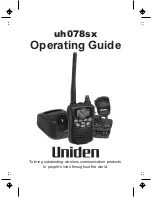
| 47
Channel charts |
Link-6 operator manual
r) In the maritime mobile service, this frequency is reserved for
experimental use for future applications or systems (e.g. new
AIS applications, man over board systems,etc.).If authorized by
administrations for experimental use, the operation shall not cause
harmful interference to, or claim protection from, stations operating
in the fixed and mobile services. (WRC-12)
s) Channels 75 and 76 are also allocated to the mobile-satellite service
(Earth-to-space) for the reception of long-range AIS broadcast
messages from ships (Message 27; see the most recent version of
Recommendation ITU-RM.1371). (WRC-12)
w. In Regions 1 and 3:
Until 1 January 2017, the frequency bands 157.200-157.325 MHz
and 161.800-161.925 MHz (corresponding to channels: 24, 84, 25, 85,
26 and 86) may be used for digitally modulated emissions, subject
to coordination with affected administrations. Stations using these
channels or frequency bands for digitally modulated emissions shall
not cause harmful interference to, or claim protection from, other
stations operating in accordance with Article
5
.
From 1 January 2017, the frequency bands 157.200-157.325 MHz
and 161.800-161.925 MHz (corresponding to channels: 24, 84, 25,
85, 26 and 86) are identified for the utilization of the VHF Data
Exchange System (VDES) described in the most recent version of
Recommendation ITU-R M.2092. These frequency bands may also be
used for analogue modulation described in the most recent version
of Recommendation ITU-R M.1084 by an administration that wishes
to do so, subject to not causing harmful interference to, or claiming
protection from other stations in the maritime mobile service using
digitally modulated emissions and subject to coordination with
affectedadministrations. (WRC-15)
ww. In Region 2, the frequency bands 157.200-157.325 and 161.800-
161.925 MHz (corresponding to channels: 24, 84, 25, 85, 26
and 86) are designated for digitally modulated emissions in
accordance with the most recent version of Recommendation
ITU-R M.1842.
In Canada and Barbados, from 1 January 2019 the frequency
bands 157.200-157.275 and 161.800-161.875 MHz (corresponding
to channels: 24, 84, 25 and 85) may be used for digitally
modulated emissions, such as those described in the most
recent version of Recommendation ITU-R M.2092, subject to
coordination with affected administrations.
(WRC-15)
x) From 1 January 2017, in Angola, Botswana, Lesotho, Madagascar,
Malawi, Mauritius, Mozambique, Namibia, Democratic Republic of
the Congo, Seychelles, South Africa, Swaziland, Tanzania, Zambia
Summary of Contents for Link-6
Page 1: ...ENGLISH Link 6 User Guide lowrance com ...
Page 56: ......
Page 57: ......
Page 58: ... 988 11181 002 ...












































